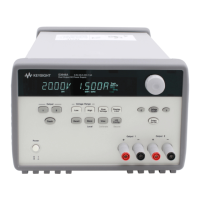Current Sharing Tutorial
Current Sharing Calculations
Sharing Deviation for Units of Equal Power (either 1 kW or 2 kW)
Sharing Deviation for Units of Mixed Power (1 kW paralleled with 2 kW)
This section describes how to calculate the current sharing effects of paralleled units of equal and
mixed power. These only affect the operation of the paralleled units when operating near the current
limit setting in voltage priority mode, operating near the voltage limit setting in current priority mode,
or when using the low current measurement range. For a description of the current sharing operation,
refer to Current Sharing.
Current Sharing Calculations
In an ideal current sharing configuration, the total load current would be shared equally among all
paralleled power supplies.
I
OUT(1kW_IDEAL)
=I
LOAD_TOTAL
/ (N
T
+N
2kW
)
I
OUT(2kW_IDEAL)
=2(I
LOAD_TOTAL
) / (N
T
+N
2kW
)
where:
I
LOAD_TOTAL
is the total load current
N
T
is the total number of paralleled units of any rating
N
2kW
is the total number of paralleled 2 kW units
The difference between the ideal output current and the actual output current for a single contributing
paralleled unit can be expressed in the form of a gain error, G and offset error, K as shown.
∆I
OUT(WORST_CASE)
=±G(I
OUT(IDEAL)
) ±K(I
RATING
)
where:
G is the gain error
K is the offset error
In a 1 kW configuration, the I
RATING
is the rated current for the 1 kW unit
In a 2 kW configuration, the I
RATING
is the rated current for the 2 kW unit
In a mixed power configuration, the I
RATING
is the rated current for the 2 kW unit
The following sections describe how to calculate the worst-case deviation from the ideal current for
each contributing paralleled unit.
4 Using the Advanced Power System
182 Keysight N6900/N7900 Series Operating and Service Guide

